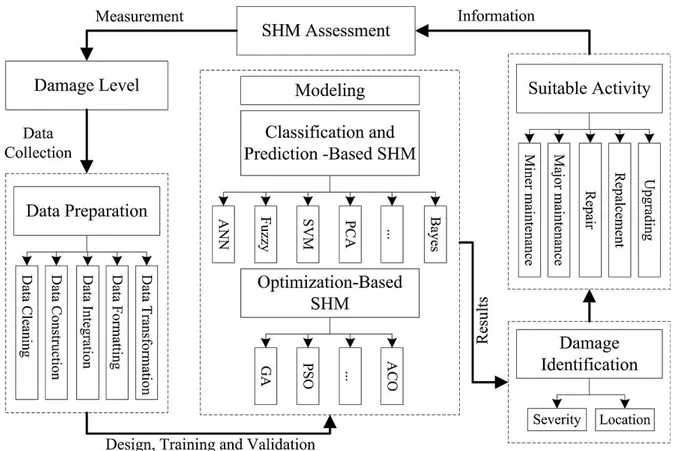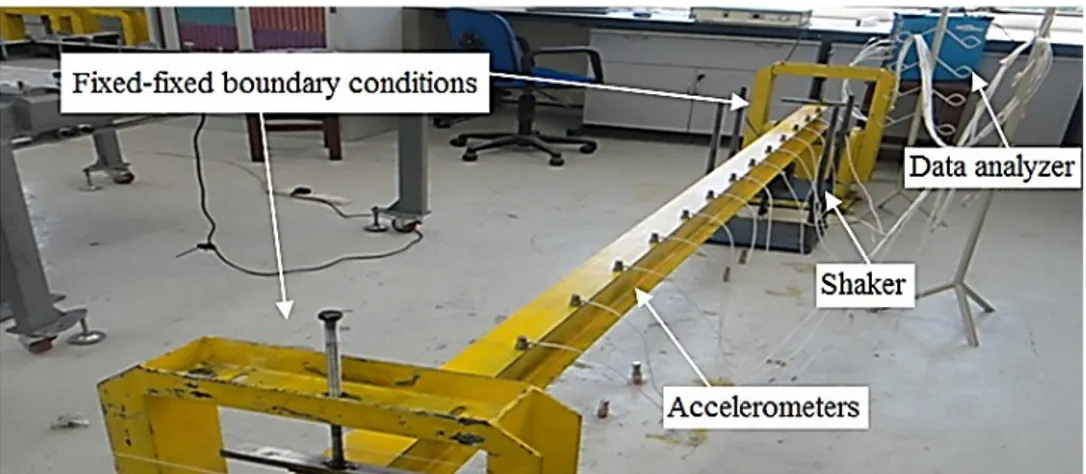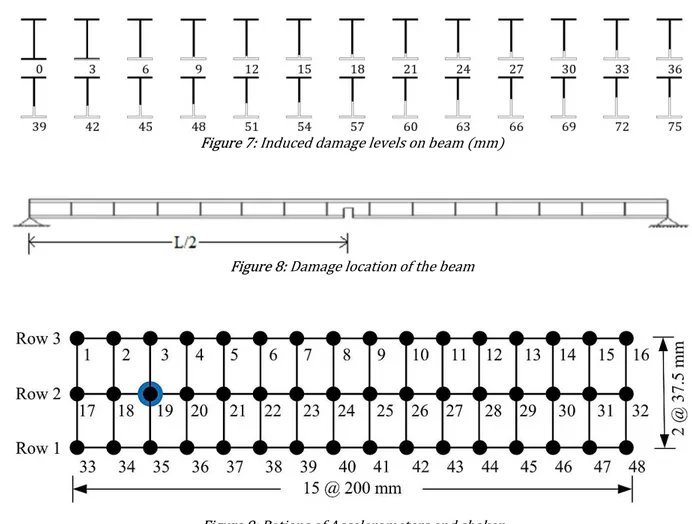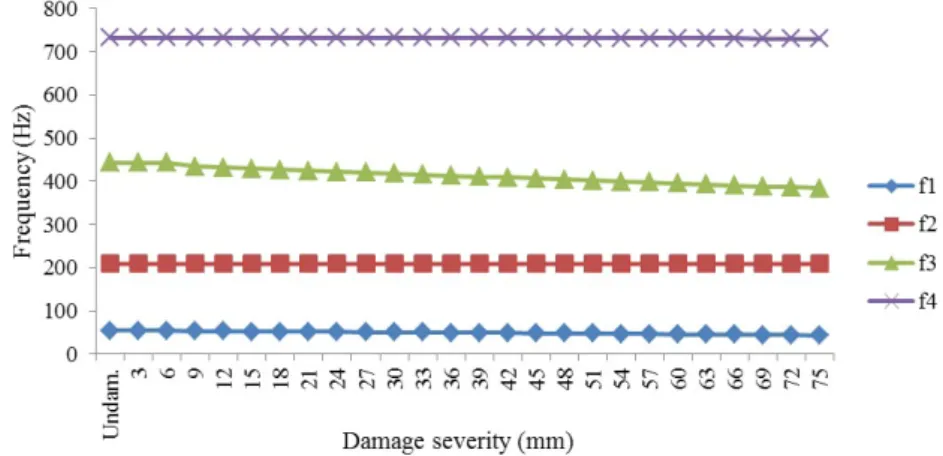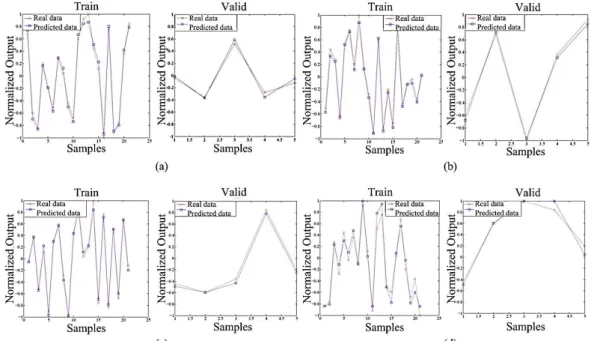Data mining based damage identification using imperialist
competi-tive algorithm and artificial neural network
Abstract
Currently, visual inspections for damage identification of structures are broadly used. However, they have two main drawbacks; time limitation and qualified manpower accessibility. Therefore, more precise and quicker technique is required to monitor the condition of structures. To aid the aim, a data mining based damage identification approach can be utilized to solve these drawbacks. In this study, to predict the damage severity of sin-gle-point damage scenarios of I-beam structures a data mining based dam-age identification framework and a hybrid algorithm combining Artificial Neural Network (ANN) and Imperial Competitive Algorithm (ICA), called ICA-ANN method, is proposed. ICA is employed to determine the initial weights of ANN. The efficiency coefficient and mean square error (MSE) are used to evaluate the performance of the ICA-ANN model. Moreover, the proposed model is compared with a pre-developed ANN approach in order to verify the efficiency of the proposed methodology. Based on the ob-tained results, it is concluded that the ICA-ANN indicates a better perfor-mance in detection of damage severity over the ANN method used only.
Keywords
Structural health monitoring; damage detection; data mining; artificial neural network; imperial competitive algorithm; hybrid algorithm
1 INTRODUCTION
To prevent structural damage under vibrational loadings, different techniques, approaches and systems have so far used (Ghaedi et al. 2017), because structural damage can disturb safety and serviceability of civil struc-tures. To this end, damage detection techniques are used to avoid catastrophic structural failure (Hakim et al. 2015). One of the common non-destructive damage identification techniques is visual inspection methods, but they are time consuming and costly due to accessibility of qualified manpower. In addition, their efficiency is lim-ited to availability of structural damage locations. As a result, more precise and quicker technique should be used to monitor the structural health condition of structures (Hoseini et al. 2012; Hakim and Razak 2014; Hanif et al. 2016). On the other hand, data mining is commonly considered as one of the newest computing technologies which is rapidly emerging; capable of data extraction to discover useful information using collected sensor data (Saitta et al. 2009; Hou et al. 2013). Important knowledge and relationship between sensor data can then be ex-tracted from raw databases using data mining technique.
In recent years, data mining techniques have been used in structural health monitoring (SHM). However, there is no straightforward workflow for data mining based SHM problems. For purpose of data mining analysis, a systematic model and applicable data mining methods are required. Therefore, a data mining process scheme along with optimization- and prediction- based algorithms was proposed by the authors (Gordan et al. 2017) to identify the severity and location of damage. Then, in the present study, an attempt has been made to demon-strate the feasibly of the proposed data mining based procedure.
On the other hand, in recent years, Artificial Neural Network (ANN) has obtained extensive attentions for damage detection of structures due to its high pattern recognition capability (Saeed et al. 2011). Nowadays many meta-heuristic-based biological evolution algorithms exist, for instance, genetic algorithm (Mitchell 1998), parti-cle swarm optimization (Xue et al. 2013), ant colony optimization (Zhou et al. 2013), artificial immune algorithm
Meisam Gordana*
Hashim Abdul Razaka
Zubaidah Ismailb*
Khaled Ghaedib
a StrucHMRSGroup, Department of Civil
Enginee-ring, University of Malaya, 50603, Kuala Lumpur, Malaysia. E-mail:
hashim.abdulrazak@gmail.com, hashim@um.edu.my, mei-sam.gordan@gmail.com
b Department of Civil Engineering, University of
Malaya, 50603, Kuala Lumpur, Malaysia. E-mail: zu_ismail@um.edu.my,
khaledqhae-di@yahoo.com
* Corresponding authors
http://dx.doi.org/10.1590/1679-78254546
(Poteralski et al. 2013), firefly algorithm (Zhou et al. 2014), artificial bee colony algorithm (Civicioglu and Besdok 2013) and grey wolf optimization (Noshadi et al. 2015). However, meta-heuristic evolutionary algorithms are not limited to biological evolution. Since another side of evolution can be employed as a meta-heuristic algorithm, humans’ social political behavior has been used for this purpose. To this end, in recent years, an evolutionary strategy has been introduced, known as Imperialist Competitive Algorithm (ICA) (Atashpaz-Gargari and Lucas 2007). This evolutionary strategy has shown its high performance to achieve better global optima with fast con-vergence speed in compare to other evolutionary algorithms (Atashpaz Gargari et al. 2008; Taghavifar et al. 2013). Therefore, ICA has also been applied into ANN method to determine the parameters of network structure (Berneti and Shahbazian 2011; Ahmadi et al. 2013).
Based on the above descriptions, in the present study an attempt is made to investigate the applicability of data mining for improvement of damage identification of beam-like structures by means of the presented model (Gordan et al. 2017) to propose ANN-ICA approach combining ANN and ICA. Experimental modal analysis of I-beam structure was carried out to generate natural frequencies and mode shapes measurements as the input database for data mining process to predict the severity of damage scenarios in I-beam structures. Totally, four individual networks corresponding to the first four modes were modeled to identify the damage severity. The database was applied to train the ANN, when the ICA was employed as weight initialization algorithm to optimize the initial weights of the ANN in the training procedure. Then, the proposed ICA-ANN method was compared with a pre-developed ANN in order to verify the efficiency of the proposed methodology. To the best of our knowledge, current research is the first attempt to illustrate the feasibly of data mining based procedure in SHM.
2 Data Mining
Figure 1: Data mining functions.
Table 1: Data mining techniques.
Data mining technique Category Learning type
Artificial neural network Artificial intelligence Supervised/Unsupervised
Support vector machine Machine learning Supervised
Decision tree Statistical Supervised
Clustering Statistical Unsupervised
Principal component analysis Machine learning Unsupervised
Regression Statistical Supervised
Fuzzy Artificial intelligence Supervised/Unsupervised
Meta-heuristics Artificial intelligence ‒
Classification Statistical Supervised
Bayesian Machine learning Supervised
Figure 2: Diagram of the proposed data mining based damage identification procedure (Gordan et al. 2017).
3 Methodology
In this study, dynamic parameters of an I-beam structure through an experimental modal test were conduct-ed as an input database for data mining procconduct-edure using the proposconduct-ed model. The hybrid ICA-ANN technique was performed to predict the severity of damage including the first four flexural modes and all corresponding modes shape values at the points on the beam centerline (supports were excluded). Subsequent writings attempt to give a brief introduction to ANN and ICA in order to present how they are used in the study.
3.1 Artificial Neural Network (ANN)
ANN algorithm, introduced in 1980s, uses human brain simulation based on the development of biological neuron. Main components of a biological neuron are a cell body, axons, dendrites and synapses, which are the main concept to formulate artificial neurons. In the biological neuron, input signals are transferred by the den-drites into the cell body and axons carry the output signals from one neuron to others, while synapses are the point contacts between dendrites of one cell and axon of another cell. Principal parts of an artificial neuron are connection weights, bias and activation functions (Singh et al. 2010; Nascimento et al. 2011; Shahriar and Nehdi 2011; Karacý and Arýcý 2014; Ahmed et al. 2015).
MSE =∑ ( ) (1) where n is the number of the training, ti is the target output and oi is the network output.
3.2 Imperialist Competitive Algorithm (ICA)
ICA is one of the latest metaheuristic algorithms in the evolutionary computation domain based on human being’s sociopolitical evolution. It was introduced by Atashpaz-Gargari and Lucas in 2007 (Ebrahimi et al. 2014). The goal of this optimization technique is to find a solution that represents the global maximum or minimum of a fitness function (Geetha Devasena et al. 2016). ICA is based on the imperialistic competition and it starts with initial populations called countries. Countries in ICA are corresponding to chromosomes in genetic algorithm. In ICA, countries categorize into two groups; colony and imperialist. These two groups create an empire. Figure 3 depicts ICA flowchart to show its procedure.
Figure 3: Flowchart of ICA.
According to Figure 3, in a N-dimensional optimization problem, a country (Pi) is shown by 1 × N array which is as follows:
Country = [P1, P2, …, PNvariable] (2)
Corresponding cost function of the country is described as,
Cost = f(country) = f([P1, P2, …, PNvariable]) (3)
Based on the optimization terminology, the imperialists are countries with the least cost. The normalized cost of an imperialist (Cn) for colonization of the counties is determined as:
Cn = maxi{ci}-cn (4)
where maxi{ci} is the imperialist with maximum cost (weakest imperialist) and Cn is the cost of n-th imperialist. The normalized power of each imperialist (Pn) is:
𝑃𝑛= 𝐶𝑛 ∑𝑁𝑖𝑚𝑝𝑒𝑟𝑖𝑎𝑙𝑖𝑠𝑡𝑖=1 𝐶𝑖
N.Cn = round {Pn . Ncolony} (6) where round is a function represented the round numbers and Ncolony is the total number of initial colonies.
Figure 4 illustrates the next step, which is the movement of colonies towards their proper imperialist. As shown in this figure, the colony moves to the imperialist by x units, which is obtained by:
x ≈ U (0, â x d) (7)
where d is the initial distance between the colony and imperialist. â is a random number (1< â≤2).
Figure 4: Movement of colonies toward their proper imperialist.
The total power of an imperialist is taken as:
T.Cn = Cost (Imperialsitn) + îmean{Cost(colonies of impiren)} (8)
where T.Cn is the total cost of Nth empire, and î is a positive number (0<î<1).
3.3 Modeling
Any ANN architecture has different features for training, such as, topology of the network, types of data, number of neurons in each layer, forms of activations, the weights and parameter settings of the network. There-fore, these criteria play important roles to construct the best network. In this study, amongst ANN functions, the back-propagation (BP) algorithm in feed-forward network with different topologies was assessed in order to obtain high quality patterns with the best forecasting capacity. However, the training process carries on updating and changing the connectivity weights up to the satisfactory level, the drawbacks of over-fitting and inefficient optimal topologies can reduce the accuracy of the network. Thus, ICA was employed in the training procedure of ANN to initialize the weights of the network. The variance of the predicted output and target output was consid-ered as network error. In fact, reducing the network error was the main purpose in ANN training. Consequently, the Mean Square Error (MSE) was considered as a cost function in ICA. Hence, the most important goal of pro-posed algorithm was to minimize MSE cost function. As a result, ICA was obtained by means of the subsequent factors: the number of initial counties set to 100; imperialists set to 15 and coefficient â set to 2.
In this study, for identification of damage severity, four networks corresponding to mode 1 to mode 4 were modeled and a hybrid ICA-ANN technique was applied to build the pattern. The neural network was trained by means of ICA to perform optimization of weights for all nodes and bias terms. To build the patterns, the hybrid ICA-ANN technique was proposed using modeling step of data mining process and four networks corresponding to first four modes of vibration were modeled. The modeling phase of damage identification process started with the ICA-ANN design using the measured natural frequencies and all the mode shapes data (excluding the support positions) were obtained from mode 1. Consequently, a dataset comprising fifteen neurons in the input layer and one neuron in the output layer of the ICA-ANN was created. The first natural frequency (f1) and fourteen mode shapes (ϕ1,2, ϕ1,3, ϕ1,4, …, ϕ1,14, ϕ1,15) of mode 1 were considered as inputs of the ICA-ANN.
3.4 Experimental test
An I-beam with length of 3200 mm with an overhang of 100 mm at both ends was studied. The flange width and section depth of the beam are 75 mm and 150 mm, respectively. Besides, the thickness of the flange and web are 5 mm and 7 mm, respectively. For material properties of the beam, the elasticity modulus of 2.1×1010 kg/m2,
mass density of 7867 kg/m3 and Poisson’s ratio of 0.2 were used. The experimental setup and a schematic
dia-gram of experimental modal analysis of the beam are shown in Figures 5 and 6.
Figure 5: Experimental setup of the specimen.
Figure 6: Schematic diagram of the experimental setup.
3.5 Data collection
The first step of the proposed model was measuring the damage levels to collect data. This step was started with collecting an initial data and then continued with activities in order to get familiar with the data. It was at-tempted to collect dynamic parameters of first four flexural modes obtained from the experimental modal analy-sis of the intact and damaged beam as input dataset for data mining. To aid the aim, the measured frequency re-sponse functions obtained from different damage scenarios were employed to identify natural frequencies and mode shapes of the structures.
3.6 Data preparation
In this step, the final dataset, which was used in the modeling step, must have been constructed from initial raw databases. Thus, a number of preparation tasks were considered in this step including data selection, data cleaning, data construction, data integration, data formatting and data transformation. For example, data cleaning aims to choice inapplicable and misplaced data in the dataset (Fernandez et al. 2002) and data integration trans-forms the raw data into various formats (Saltan et al. 2011).
4 Results and discussions
8. Figure 9 displays the arrangement of the accelerometers considered for 48 points in three rows between sup-ports. As it can be seen from this figure, the location of node No. 19 was chosen as the excitation point of the ex-periment due to the node points in other locations using first four modes. The outputs of the exex-perimental modal analysis were then used as the input database for data mining procedure.
Figure 7: Induced damage levels on beam (mm)
Figure 8: Damage location of the beam
Figure 9: Potions of Accelerometers and shaker
Based on the damage identified from data collection and data preparation, first four modal parameters of the undamaged and damaged states were extracted, as tabulated in Table 2 and plotted in Figure 10. Accordingly, the natural frequencies of all the modes reduce with damage severity expansion. The most reduction of natural fre-quency was 21.3% for mode 1.
Table 2: Frequencies of intact beam.
Mode 1 f1 (Hz)
Mode 2 f2 (Hz)
Mode 3 f3 (Hz)
Mode 4 f4 (Hz)
Figure 10: Frist four natural frequencies of damage states.
Table 3 indicates damage severities pertaining to the dd/h ratio for various cut slots, in which dd is the dam-age depth and h is the height of the beam. This table shows the 25 damage cases, from 2% to 50% created in the beam.
Table 3: Damage severity ratio.
Cut slot (mm) dd/h Cut slot (mm) dd/h Cut slot (mm) dd/h
3 0.02 30 0.20 57 0.38
6 0.04 33 0.22 60 0.40
9 0.06 36 0.24 63 0.42
12 0.008 39 0.26 66 0.44
15 0.10 42 0.28 69 0.46
18 0.12 45 0.30 72 0.48
21 0.14 48 0.32 75 0.50
24 0.16 51 0.34 - -
27 0.18 54 0.36 - -
Figure 11: Comparison between results of damage identification in (a) mode 1, (b) mode 2, (c) mode 3, and (d) mode 4
4.1 Pattern assessment
It is important to assess the proposed model built by ICA-ANN. Hence, the purpose of the pattern assessment is to validate the model in an appropriate manner. For this purpose, different tools can be utilized. In this study, the basis of efficiency coefficient (R2) and MSE were used to evaluate the performance of the ICA-ANN model.
MSE was also considered as a cost function in ICA. The main goal of proposed algorithm was to minimize
MSE cost function. The best costs of the four ICA-ANN models are listed in Table 4. It can be seen from the table that, the cost function of the network N1 is less than others, which shows the higher accuracy of this model to
pre-dict the severity of damage. In this phase, a comparison of ICA-ANN and ANN was carried out to evaluate the per-formance of the ICA-ANN. Figure 12 presents the perper-formance of the predicted values of the ICA-ANN and the ANN using efficiency coefficient. As shown in the figure, the measured and predicted values of damage severity obtained from the ICA-ANN with R2=0.9988 is better than that obtained from the ANN with R2=0.9366.
Table 4: Performance of different ICA-ANN networks.
Network Best cost of the network
N1 (Mode 1) 0.0029
N2 (Mode 2) 0.0037
N3 (Mode 3) 0.0042
N4 (Mode 4) 0.0041
4.2 Deployment
The ICA-ANN model creation and prediction of the damage severity of single-type damage scenarios acquired from the experimental modal analysis of the I-beam structure is not the last step of the project. The achieved knowledge from data mining process should be employed for the future uses in decision making processes. In this regard, the outputs of the project were utilized as follows:
• Implementation of the real-time structural health monitoring of civil infrastructures; • Prediction the remaining life of structures;
• Development a robust damage detection system.
5 Conclusion
In this research, a data mining approach was performed as data extraction method using a proposed hybrid ICA-ANN algorithm to predict the damage severity of single-point damage scenarios picked up from the experi-mental modal analysis of a beam-like structure. The ICA as a new optimization data mining algorithm and as a weight initialization algorithm was used to optimize the initial weights of the ANN in the training procedure. The ANN was implemented to examine the performance of the ICA-ANN using the efficiency coefficient and MSE. Based on the obtained results, the following conclusions are drawn.
• Capability of the proposed data mining-based damage identification model in SHM domain to predict damage severity of the steel I-beams was confirmed through data mining process.
• 6.23% improvement in the prediction error using the ICA-ANN showed the robustness of the proposed hybrid algorithm compared to the prediction using ANN. It is noted that, several deployment processes such as real-time data processing for vibration-based damage detection techniques, prediction of the remaining service life of structures and development a robust SHM system have so far been introduced to improve the identification of damage severity as knowledge discovery.
• The obtained results through ICA-ANN using the proposed procedure showed that, the proposed damage identification model can be considered as a precise and quick approach for monitoring the structural condition subjected to vibrational loads.
• Based on different damage rates, minor maintenance, major maintenance or their combination is required to maintain the structural performance of the members.
Acknowledgements
The authors would like to express their sincere thanks to University of Malaya (UM) and the Ministry of Edu-cation (MOE), Malaysia for the support given through research grants PG144-2016A and UM.C/625/1/HIR/MOHE/ENG/55.
References
Ahmadi MA, Ebadi M, Shokrollahi A, et al (2013) Evolving artificial neural network and imperialist competitive algorithm for prediction oil flow rate of the reservoir. Appl Soft Comput J 13:1085–1098.
Ahmed R, El Sayed M, Gadsden SA, et al (2015) Artificial neural network training utilizing the smooth variable structure filter estimation strategy.
Alves V, Cremona C, Cury A (2015a) On the use of symbolic vibration data for robust structural health monitoring. Proc Inst Civ Eng Build 169:715–723.
Alves V, Cury A, Roitman N, et al (2015b) Structural modification assessment using supervised learning methods applied to vibration data. Eng Struct 99:439–448.
Aydin K, Kisi O (2014) Applicability of a Fuzzy Genetic System for Crack Diagnosis in Timoshenko Beams. J Com-put Civ Eng 29:04014073.
Azevedo A, Santos MF (2008) KDD, SEMMA AND CRISP-DM:A Parallel Overview. In: IADIS European Conference Data Mining. IADIS, pp 182–185
Berneti SM, Shahbazian M (2011) An Imperialist Competitive Algorithm-Artificial Neural Network Method to Pre-dict Oil Flow Rate of the Wells. Int J Comput Appl 26:47–50.
Chen TY, Huang JH (2013) Application of data mining in a global optimization algorithm. Adv Eng Softw 66:24–33. Civicioglu P, Besdok E (2013) A conceptual comparison of the Cuckoo-search, particle swarm optimization, differ-ential evolution and artificial bee colony algorithms.
Cottone G, Fileccia Scimemi G, Pirrotta A (2014) á-stable distributions for better performance of ACO in detecting damage on not well spaced frequency systems. Probabilistic Eng Mech 35:29–36.
Cury A, Cremona C (2012) Pattern recognition of structural behaviors based on learning algorithms and symbolic data concepts. Struct Control Heal Monit 19:161–186.
Ebrahimi E, Mollazade K, Babaei S (2014) Toward an automatic wheat purity measuring device : A machine vi-sion-based neural networks-assisted imperialist competitive algorithm approach. Measurement 55:196–205. Fernandez IB, Zanakis SH, Walczak S (2002) Knowledge discovery techniques for predicting country investment risk. Comput Ind Eng 43:787–800.
Geetha Devasena MS, Gopu G, Valarmathi ML (2016) Automated and Optimized Software Test Suite Generation Technique for Structural Testing. Int J Softw Eng Knowl Eng 26:1–13. doi: 10.1142/S0218194016500017
Ghaedi K, Ibrahim Z (2017) Earthquake Prediction. In: Zouaghi T (ed) Earthquakes - Tectonics, Hazard and Risk Mitigation. InTech, pp 205–227
Ghaedi K, Ibrahim Z, Adeli H (2017) Invited Review: Recent developments in vibration control of building and bridge structures. J Vibroengineering 19:3564 3580.
Gordan M, Razak HA, Ismail Z, Ghaedi K (2017) Recent developments in damage identification of structures using data mining. Lat Am J Solids Struct 1–27.
Hakim SJS, Abdul Razak H, Ravanfar S A. (2015) Fault diagnosis on beam-like structures from modal parameters using artificial neural networks. Measurement 76:45–61. doi: 10.1016/j.measurement.2015.08.021
Hakim SJS, Razak HA (2014) Modal parameters based structural damage detection using artificial neural net-works - a review. Smart Struct Syst 14:159–189.
Han J, Pei J, Kamber M (2001) Data mining - Concepts and Techniques. Morgan Kauffman Hand DJ, Mannila H, Smyth P (2001) Principles of Data Mining. MIP press
Hanif MU, Ibrahim Z, Jameel M, et al (2016) A new approach to estimate damage in concrete beams using non-linearity. Constr Build Mater 124:1081–1089.
Hoseini MR, Wang X, Zuo MJ (2012) Estimating ultrasonic time of flight using envelope and quasi maximum like-lihood method for damage detection and assessment. Meas J Int Meas Confed 45:2072–2080.
Hou Z, Hera A, Noori M (2013) Wavelet-Based Techniques for Structural Health Monitoring. In: Health Assess-ment of Engineered Structures: Bridges, Buildings and Other Infrastructures. World Scientific, pp 179–202
Hsu T, Loh C (2010) Damage detection accommodating nonlinear environmental effects by nonlinear principal component analysis. Struct Control Heal Monit 17:338–354.
Jiang X, Mahadevan S (2008) Bayesian Probabilistic Inference for Nonparametric Damage Detection of Structures. J Eng Mech 134:820–832.
Kabir S, Rivard P, Ballivy G (2008) Neural-network-based damage classification of bridge infrastructure using texture analysis. Can J Civ Eng 35:258–267.
Karacý A, Arýcý N (2014) Determining students’ level of page viewing in intelligent tutorial systems with artificial neural network. Neural Comput Applic 24:675–684.
Kim S, Frangopol DM, Zhu B (2011) Probabilistic Optimum Inspection / Repair Planning to Extend Lifetime of Deteriorating Structures. J Perform Constr Facil 25:534–545.
Laory I, Trinh TN, Posenato D, Smith IFC (2013) Combined Model-Free Data-Interpretation Methodologies for Damage Detection during Continuous Monitoring of Structures. J Comput Civ Eng 27:657–666.
Liao S-H, Chu P-H, Hsiao P-Y (2012) Data mining techniques and applications – A decade review from 2000 to 2011. Expert Syst Appl 39:11303–11311.
Mitchell M (1998) An Introduction to Genetic Algorithms. MIT Press
Nascimento TM, Boccardo DR, Prado CB, et al (2011) Program Matching Through Code Analysis and Artificial Neural Networks.
Noshadi A, Shi J, Lee WS, et al (2015) Optimal PID-type fuzzy logic controller for a multi-input multi-output active magnetic bearing system. Neural Comput Appl. doi: 10.1007/s00521-015-1996-7
Obenshain MK (2004) Application of data mining techniques to healthcare data. Infect Control Hosp Epidemiol 25:690–695.
Palomares-Salas JC, Agüera-Pérez A, Rosa JJG de la, Moreno-Muñoza A (2014) A novel neural network method for wind speed forecasting using exogenous measurements from agriculture stations. Meas J Int Meas Confed 55:295–304.
Pang-Ning T, Steinbach M, Kumar V (2006) Introduction to data mining. Pearson Addison-Wesley, Boston
Poteralski A, Szczepanik M, Dziatkiewicz G, et al (2013) Comparison between PSO and AIS on the Basis of Identifi-cation of Material Constants in Piezoelectrics. Artif Intell Soft Comput Pt Ii 7895:569–581. doi: http://dx.doi.org/10.1007/978-3-642-38610-7_52
Rus G, Lee SY, Chang SY, Wooh SC (2006) Optimized damage detection of steel plates from noisy impact test. Int J Numer Methods Eng 68:707–727.
Saitta S, Raphael B, Smith IFC (2009) Data Mining : applications in civil engineering. VDM, Saarbrücken
Saltan M, Terzi S, Ug E (2011) Backcalculation of pavement layer moduli and Poisson’s ratio using data mining. Expert Syst Appl 38:2600–2608.
Shahriar A, Nehdi ML (2011) Modeling Rheological Properties of Oil Well Cement Slurries Using Artificial Neural Networks. J Mater Civ Eng 23:1703–1710.
Singh Y, Kaur A, Bhatia PK, Sangwan O (2010) Predicting Software Development Effort Using Artificial Neural Network. Int J Softw Eng Knowl Eng 20:367–375.
Tabrizian Z, Afshari E, Ghodrati G, et al (2013) A new damage detection method : Big Bang-Big Crunch (BB-BC) algorithm. Shock Vib 20:633–648.
Taghavifar H, Mardani A, Taghavifar L (2013) A hybridized artificial neural network and imperialist competitive algorithm optimization approach for prediction of soil compaction in soil bin facility. Measurement 46:2288– 2299.
Taha MMR, Noureldin A, Osman A, El-Sheimy N (2004) Introduction to the use of wavelet multiresolution analysis for intelligent structural health monitoring. Can J Civ Eng 31:719–731.
Talatahari S, Mohajer N (2015) Enriched Imperialist Competitive Algorithm for system identification of magneto-rheological dampers. Mech Syst Signal Process 62-63:506–516.
Tayyebi A, Pijanowski BC, Linderman M, Gratton C (2014) Comparing three global parametric and local non-parametric models to simulate land use change in diverse areas of the world. Environ Model Softw 59:202–221. doi: 10.1016/j.envsoft.2014.05.022
Wu Z, Xu B, Yokoyama K (2002) Decentralized parametric damage detection based on neural networks. Comput Civ Infrastruct Eng 17:175–184.
Xue B, Zhang MJ, Browne WN (2013) Particle swarm optimization for feature selection in classification: a multi-objective approach. IEEE Trans Cybern 43:1656–1671.
Zhou G, Yi T, Li H (2014) Sensor Placement Optimization in Structural Health Monitoring Using Cluster-in-Cluster Firefly Algorithm. Adv Struct Eng 17:1103–1116.

